The trait shown in the given pedigree chart is most likely a/an:
1. Autosomal recessive trait
2. Autosomal dominant trait
3. Sex linked recessive trait
4. Sex linked dominant trait
The type of population interaction exhibited by visiting flamingos and resident fishes in South American Lakes, is also shown by
1. Sparrow eating any seed.
2. Cuckoo and crow.
3. Abingdon tortoise and goats in Galapagos island.
4. Sea anemone and clown fish.
The phytohormone that speed up the malting process in brewing industry is also responsible for
| a. | Initiates rooting in stem cutting. |
| b. | Increases chloroplast in leaves. |
| c. | Promotes root hair formation. |
| d. | Inhibits seed germination. |
| e. | Promotes seed germination. |
| d. | Promotes internode elongation just prior to flowering. |
1. a and c
2. b and d
3. d and f
4. e and f
In Pteridophytes reduction division occurs
during
1. spore formation
2. gamete formation
3. sporophyte formation
4. gametophyte germination
Consider the following four statements A, B, C and D and select the right option for two correct statements.
(A) In vexillary aestivation, the large posterior petal is called standard, two lateral ones
are wings and two small anterior petals are termed keel
(B) The floral formula for Liliaceae is
(C) In pea flower the stamens are monadelphous
(D) The floral formula for Solanaceae is
The correct statements are
1. (A) and (C)
2. (A) and (B)
3. (B) and (C)
4. (C) and (D)
Placentations given below in the diagrams are
1. a - Basal, b- Axile, c- Free central, d - Parietal
2. a - Marginal, b- Axile, c- Basal, d - Superfecial
3. a - Marginal, b- Free central, c- Basal, d - Axile
4. a - Marginal, b- Axile, c- Parietal, d - Free central
Which of the following is a disease caused by
prion?
1. Kala-azar
2. Parkinson’s disease
3. Creutzfeldt-Jacob disease
4. Gas gangrene
A free living aerobic soil bacterium capable of
fixing nitrogen is
1. Azotobacter
2. Clostridium
3. Rhizobium
4. Streptococcus
In a longitudinal section of a root, starting from
the tip upward, the four zones occur in the
following order
1. Cell division, cell maturation, cell enlargement,
root cap
2. Root cap, cell division, cell maturation, cell
enlargement
3. Root cap, cell division, cell enlargement, cell
maturation
4. Cell division, cell enlargement, cell maturation,
root cap
As a contraception method, term sterilisation is used
for
1. Removal of testis
2. Vasectomy
3. Tubectomy
4. Both (2) and (3)
Given below is the diagram of a typical structure of dicotyledonous seeds. In which one of the options all the five parts A, B, C, D and E correct?
1. A – Hilum, B – Micropyle, C – Radicle, D – Cotyledon, E – Plumule
2. A – Hilum, B – Micropyle, C – Plumule, D – Cotyledon, E – Radicle
3. A – Micropyle, B – Hilum, C – Plumule, D – Cotyledon, E – Radicle
4. A – Hilum, B – Micropyle, C – Plumule, D – Radicle, E - Cotyledon
Which of the following statements about classification is not true?
| I. | Members of a family are less similar than members of an included genus. |
| II. | An order has more members than the number of members in an included genus. |
| III. | Families have more members than phyla. |
| IV. | The number of species in a taxon depends on their relative degree of similarity. |
1. Only III
2. Only IV
3. Only II
4. Only I
Consider the following statements (A – D) about organic farming:
(i) Utilizes genetically modified crops like Bt cotton.
(ii) Uses only naturally produced inputs like compost.
(iii) Does not use pesticides and urea.
(iv) Produces vegetables rich in vitamins and minerals.
Which of the above statements are correct?
1. (ii), (iii) and (iv)
2. (iii) and (iv) only
3. (ii) and (iii) only
4. (i) and (ii) only.
Identify the incorrect statement regarding the blood vascular system of cockroach:
| 1. | Blood vessels are poorly developed and open into hemocoel |
| 2. | The hemolymph is composed of colourless plasma and hemocytes |
| 3. | Heart lies along the mid-ventral line of thorax and abdomen |
| 4. | Blood from sinuses enter heart through ostia |
Adipose tissue and areolar tissue are considered as:
1. Loose connective tissue and dense connective tissue respectively.
2. Dense regular and dense irregular tissue respectively.
3. Both are specialised connective tissue.
4. Both are loose connective tissue.
Mucus neck cell is a part of
1. Gastric gland.
2. Intestinal gland.
3. Salivary gland.
4. Both 1 and 2
Mark the incorrect match:
|
1. |
Cerebral aqueduct |
→ |
A canal passes through the midbrain, connecting 3rd ventricle to 4th ventricle of brain. |
|
2. |
Corpus callosum |
→ |
Thick band of nerve fibres that divides the cerebral cortex lobes into left and right hemispheres. |
|
3. |
Limbic system |
→ |
The inner part of forebrain involved in the regulation of sexual behaviour. |
|
4. |
Pons |
→ |
Consist of fibre tracts that interconnect different regions of the brain. |
Vestibular apparatus is composed of:
I. Semi-circular canals
II. Otolith organs
III. Organ of Corti
IV. Crista and macula
1. I, II, III & IV
2. I, II only
3. IV only
4. II only
‘Retinal’ is present in
1. Rods.
2. Cones.
3. Both 1 and 2.
4. All the retinal layer
___A___ and ___B___ provide micro-environments for
the development and maturation of T-lymphocytes. Here
A and B is :-
1. Spleen and thymus gland.
2. Thymus gland and MALT.
3. Bone marrow and thymus gland.
4. Spleen and MALT.
Vaccines are available for the disease like
I. Polio.
II. Diptheria.
III. Pneumonia.
IV. Tetanus.
1. I, II, III & IV
2. I and IV only
3. I only
4. I, II & IV only
Fertilization membrane is formed to
1. Faciliate entry of sperm into egg.
2. Provide stability to egg.
3. Prevent ectopic pregnancy.
4. Prevent polyspermy
Seminal plasma of humans is rich in
1. Fructose and certain enzymes, poor in Ca2+.
2. Fructose, Ca2+ and certain enzymes.
3. Fructose, Ca2+ but no enzymes.
4. Glucose, certain enzymes but no Ca2+
Which one of the following is not the function of
placenta?
1. Faciliates removal of carbon dioxide and waste
material from embryo.
2. Secrete oxytocin during parturition.
3. Faciliates supply of oxygen and nutrients to embryo.
4. Secretes estrogen.
Read the following statements carefully
| A. | Lipid component of the plasma membrane mainly consists of phosphoglycerides. |
| B. | Polar molecules can pass through the lipid bilayer of plasma membrane, therefore they do not require carrier proteins to facilitate their transport. |
| C. | Secondary wall is capable of growth and it is formed on the outer side of the cell |
| D. | Quasi fluid nature of lipid enables lateral movement of proteins within the overall lipid bilayer of plasma membrane |
| E. | Middle lamella glues the different neighbouring cells together |
How many statements are incorrect?
1. Three
2. Five
3. Four
4. Two
Which of the following are the functions of deoxyribonucleoside triphosphates?
i. Act as substrates
ii. Provide energy for polymerization reaction
iii. Act as enzyme
iv. To separate strands of DNA
1. i, ii, iii
2. ii, iv
3. i, ii
4. i, iii
The structural and catalytic role during translation is brought about by
1. mRNA
2. tRNA
3. rRNA
4. Both 1 and 3
The cell in the pollen grain which is responsible for giving rise to male gamete is
1. Rod shaped with dense cytoplasm
2. Of smaller size and float in the cytoplasm
3. Capable of dividing meiotically and give rise two male gamete
4. It has abundant food reserve and large irregularly shaped nucleus.
During the formation of embryo sac
1. The mitotic divisions are strictly cellular.
2. Three cells present at the micropylar end are called antipodals.
3. Six of the 8 nuclei are surrounded by cell wall.
4. There is development of special thickening called filiform apparatus at chalazal end.
The meristem that occurs in mature regions of roots and shoots of dicots and appears later than primary meristem is formed at the result of _____ from _____ tissue
| 1. | Differentiation, primary meristem |
| 2. | Maturation, promeristematic |
| 3. | Dedifferentiation, primary permanent |
| 4. | Redifferentiation, secondary meristem |
Crossing over occurs just prior to
1. Pachytene
2. Diplotene
3. Diakinesis
4. Zygotene
In the figure below identify the remain of second cotyledon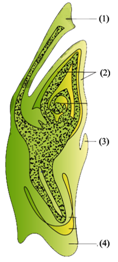
1. Scutellum
2. Coleoptile
3. Epiblast
4. Coleorhiza
Select incorrect statement for the lac operon
1. Here Lac refers to lactose
2. The i-gene is non-constitutive gene, synthesizing repressor protein
3. The y-gene codes for permease
4. The repressor protein binds to the operator region and prevents RNA polymerase activity
In nature, a given habitat has enough resources to support a maximum possible number, beyond which no further growth is possible. The limit is known as
1. Environmental resistance
2. Intrinsic rate of natural increase
3. Carrying capacity
4. Exponentially growth
The organelles formed by the process of packaging in the golgi apparatus is
| 1. | Double membrane organelle. |
| 2. | Possess single circular DNA molecule |
| 3. | Rich in hydrolases |
| 4. | Able to occupy up to 90 percent volume of the cell |
The blood from a person with an AB blood type
1. Would agglutinate with anti-A antibodies only.
2. Would agglutinate with anti-B antibodies only.
3. Would agglutinate with both anti-A and anti-B
antibodies.
4. Would not agglutinate with either anti-A of anti-B
antibodies.
Which of the following is very close to the time of
ovulation?
1. Peak of progesterone.
2. Minimum level of estrogen.
3. Peak of LH and FSH.
4. Thickest layer of endometrium.
How is the digestion and absorption of fats different from that of proteins and carbohydrates?
1. Fat digestion occurs in the small intestine, and
the digestion of proteins and carbohydrates occurs
in stomach.
2. Fats are absorbed into the cells as fatty acids and
monoglycerides but are then modified for
absorption into the blood through lacteals; amino
acids and glucose are not modified further.
3. Fats enter hepatic portal circulation, but proteins
and carbohydrates enter the lymphatic system.
4. Fats are absorbed in the large intestine and protein
and carbohydrates are absorbed in the small intestine.
Arrange the following component in the sequence of activation of blood clotting mechanism?
| (i) | Platelets | (ii) | Prothrombin |
| (iii) | Fibrinogen | (iv) | Ca++ |
| (v) | Thrombokinase |
1. (i), (ii), (iii), (iv), (v)
2. (i), (iv), (v), (ii), (iii)
3. (iii), (iv), (v), (i), (ii)
4. (v), (iv), (iii), (ii), (i)
In the accompanying diagram of a human nephron the functional parts are labelled as A, B, C, D, E.
Study the diagram to answer the questions given
| P: | Active secretion of H+ and K+ into the filtrate occurs in which parts? |
| Q: | Conditional reabsorption of Na+ and water is a function of |
| R: | Reabsorption of water is minimum in which segment? |
Choose the correct option:
| P | Q | R | |
| 1. | B,D | C | E |
| 2. | A,B,C | C | E |
| 3. | D,E | D | C |
| 4. | A,D,E | E | C |
Which of the following is not a direct method of gene transfer?
1. Microinjection
2. Biolistic
3. Electroporation
4. Disarmed pathogen vector
The process of evolution of different species in a given
geographical area starting from a point and literally
radiating to other areas of geography is called
1. Divergent evolution.
2. Adaptive radiation.
3. Adaptive convergence.
4. Parallel evolution.
All the following are present in sponges, except
1. Spicules
2. Choanocytes
3. A digestive tract
4. Sexual and / or asexual reproduction
False statement is
| 1. | Inhibition of succinic dehydrogenase by malonate can be reversed by increasing the concentration of succinate. |
| 2. | Non-competitive inhibition occurs when the inhibitor and substrate bind at different sites on the enzyme. |
| 3. | Non-competitive inhibitors do not interfere with the binding of substrate to enzyme. It can be overcome by increasing the concentration of substrate. |
| 4. | A competitive inhibitor of an enzyme increases Km without affecting Vmax |
In G phase of cell cycle
| 1. | RNA synthesis stops. |
| 2. | DNA replicates. |
| 3. | Deoxyribonucleotide synthesis begins. |
| 4. | Tubulin protein synthesis takes place. |
The interconnected cells which do not show symplastic movement of water are:
1. Mesophyll cells
2. Tracheids
3. Xylem parenchyma cells
4. Cells of endodermis
In most terrestrial plants stomata normally open in the daytime. The immediate cause of the opening of the stomata is:
1. Circular orientation of cellulose microfibrils in the guard cells.
2. Loss of water from guard cells.
3. An increase in CO concentration in the sub-stomatal cavity.
4. An increase in the turgidity of the guard cells.
Select the Incorrect statement from the following.
| 1. | Nostoc performs oxygenic photosynthesis. |
| 2. | During photorespiration, O2 is first utilized in chloroplast, and CO2 is released in mitochondria. |
| 3. | In a chloroplast, lumen of thylakoids always have least number of protons during photophosphorylation. |
| 4. | In the plants like sugarcane and Amaranthus, primary CO2 acceptor is phosphoenol pyruvate. |
Match the following columns and select the correct option.
| Column-I | Column-II |
| a. Photolysis of water | (i) C plants |
| b. Carboxylation of RuBP | (ii) Non-cyclic photophosphorylation |
| c. Synthesis of ATP only | (iii) Cyclic photophosphorylation |
| d. Consumption of 5 ATP per CO2 fixed |
(iv) Calvin cycle |
| 1. | a (ii), b (iv), c (iii), d (i) |
| 2. | a (iii), b (iv), c (ii), d (i) |
| 3. | a (ii), b (i), c (iii), d (iv) |
| 4. | a (iii), b (i), c (ii), d (iv) |
Read the following statements and choose the option which is true for them.
| Statement-I : | During conversion of succinic acid to fumaric acid in Krebs cycle, one molecule of FAD is synthesized. |
| Statement-II : | There are three steps in the Krebs cycle where CO 2 is released. |
| 1. | Only statement I is correct. |
| 2. | Only statement II is correct. |
| 3. | Both the statements I and II are correct. |
| 4. | Both the statements I and II are incorrect. |
When tripalmitin is used as substrate in respiration, the value of RQ is found to be less than one because
| 1. | It contains less number of carbon atoms than oxygen atoms. |
| 2. | The amount of CO2 evolved is more than the amount of O2 consumed. |
| 3. | The amount of O2 consumed is more than the amount of CO2 evolved. |
| 4. | The ratio of the numbers of carbon and hydrogen atoms in this molecule is not 1 : 2. |
In a flowering plant if auxins are not synthesizing, then effects which would most probably be seen in this plant are
| i | Dropping of fruits at early stage. |
| ii | Inhibition in the growth of lateral buds. |
| iii | Delayed abscission of older mature leaves. |
| iv | Inhibition of cell division in cambium. |
| 1. | i, ii and iv |
| 2. | i, iii and iv |
| 3. | ii and iv only |
| 4. | i and iii only |
Leaves of which of the following plants are involved in vegetative reproduction?
1. Opuntia
2. Potato
3. Bryophyllum
4. Sugarcane
Total sum of possible genotypes and phenotypes of
blood type amongst the children of a couple having
genotypes and can be
1. 8
2. 6
3. 7
4. 5
An individual affected with Turner's syndrome
1. Lacks X - chromosomes.
2. Has an additional copy of X- chromosome.
3. Is monosomic due to the presence of only one X - chromosome.
4. Has trisomic condition of an autosome.
By performing a series of experiments that showed the effect of R and S strains of Streptococcus pneumoniae on mice, Griffith concluded that
1. Protein digesting enzyme does not affect
transformation.
2. DNA is more stable genetic material than RNA.
3. DNA replication is semi conservative.
4. Non-virulent bacteria were tranformed by heat killed
virulent bacteria.
Match the following columns and select the correct
option
|
|
Column I |
|
Column II |
|
a. |
Phytoplanktons |
(i) |
Key industry animals |
|
b. |
Saprotrophic bacteria |
(ii) |
Pioneer community in hydrarch succession |
|
c. |
Primary consumers |
(iii) |
Pioneer community of xerarch succession |
|
d. |
Lichens |
(iv) |
Nature's scavengers |
1. a (ii), b (iv), c (i), d (iii)
2. a (iii), b (i), c (iv), d (ii)
3. a (iii), b (iv), c (i), d (ii)
4. a (ii), b (i), c (iv), d (iii)
Which of the following is an example of branched
polymer?
| 1. | Chitin. | 2. | Cellulose. |
| 3. | Amylose. | 4. | Glycogen |
Mark the correct match with the group and its characteristic?
| 1. | Arthropoda → Compound eye and wings. |
| 2. | Mammalia → Viviparity. |
| 3. | Echinodermata → Calcareous endoskeleton. |
| 4. | Annelida → Fresh water and segmented body. |
Urinary excretion is equivalent to:
GF = Glomerular filtration.
TR = Tubular reabsorption.
TS = Tubular secretion.
1. GF + TR + TS
2. GF – (TR + TS)
3. GF – TR + TS
4. GF – TS + TR
Biologists discover about 1000 species in an Island which is descended from a single ancestor species.
What is the reason behind the such large speciation?
1. Mutation
2. Adaptive radiation
3. Convergent evolution.
4. Reproductive isolation
If the gene of interest is cloned at ECoRI in pBR322,
the recombinant E-coli after transformation are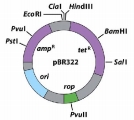
1. Susceptible to ampicillin and tetracyline.
2. Sensitive to tetracycline.
3. Resistant to kanamycin.
4. Resistant to ampicillin and tetracycline
In biotechnology transgenic animals are used for
| I. | Study of disease. |
| II. | To obtained human protein. |
| III. | Vaccine safety for humans. |
| IV. | To know the carcinogenicity of any chemicals. |
1. I, II, III and IV
2. III and IV only
3. I, III and IV
4. I and II only
From RNA interference technique
1. Toxins are made to kill soil parasites.
2. Made crops more tolerant to abiotic stresses.
3. Plants are made resistant to soil parasites.
4. Plants are developed to get the enhanced nutritional
value of food
Gene for starch synthesis in pea can show variable behaviour with respect to phenotype produced, it can show
1. Mendelian dominance
2. Multiple allelism
3. Incomplete dominance
4. More than one option is correct
Find odd one out with respect to autosomal recessive disorders
1. Cystic fibrosis
2. Myotonic dystrophy
3. Phenylketonuria
4. Sickle-cell anaemia
Verhulst-Pearl logistic growth
(a) Occurs when resources are unlimited
(b) Is expressed as
(c) Exhibits sigmoid curve
(d) Is characterized by the function of carrying capacity
1. All are correct
2. Only (a) & (b) are correct
3. Only (a) is incorrect
4. Only (b) & (c) are incorrect
Find the correct match
| 1. | Montreal Protocol – 1992 |
| 2. | Kyoto Protocol – 1997 |
| 3. | Earth Summit – South Africa |
| 4. | World Summit – Brazil |
A peptide hormone which causes dilation of blood vessels and decreases blood pressure is
1. Aldosterone
2. Adrenaline
3. Vasopressin
4. Atrial Natriuretic factor
The maximum volume of air a person can breathe in after a forced expiration is
| (A) | Vital capacity | (B) | ERV + TV + IRV |
| (C) | TLC – RV | (D) | ERV – RV |
1. (A) only
2. (A) & (B) only
3. (A), (B) & (C) only
4. (A), (B), (C) & (D)
Match the column and choose the correct answer.
| Column-I | Column-II | ||
| a. | Hypothalamus | (i) | Sperm lysin |
| b. | Acrosome | (ii) | Estrogen |
| c. | Graffian follicle | (iii) | Relaxin |
| d. | Leydig cells | (iv) | GnRH |
| e. | Parturition | (v) | Testosterone |
1. a(iv), b(i), c(ii), d(iii), e(v)
2. a(ii), b(i), c(iv), d(iii), e(v)
3. a(ii), b(i), c(v), d(iv), e(iii)
4. a(iv), b(i), c(ii), d(v), e(iii)
Which of the following respiratory centre does not play role in basic respiratory rhythms but under enhanced respiratory drive, the respiratory signals of this centre fulfil the demand by regulating both inspiration and expiration?
1. Pneumotaxic centre
2. Apneustic centre
3. Dorsal respiratory group
4. Ventral respiratory group
The option incorrect for water hyacinth is
1. Introduced in India because of its beautiful flowers
and shape of leaves.
2. Drains oxygen from water, which leads to death of
fishes.
3. Found growing wherever there is running water.
4. Grow faster than our ability to remove them.
Which of the following option is not true for penicillin?
| 1. | Its full potential as an effective antibiotic was established much later by Ernest Chain and Howard Florey. |
| 2. | This antibiotic was extensively used to treat American soldiers wounded in World War II. |
| 3. | Produced by the bacteria. |
| 4. | both 2 and 3 |
Monascus purpureus is a
i. Bacteria
ii. Yeast
iii. Produces cyclosporin A
iv. Produces statins
1. i, iii
2. ii, iii
3. i, iv
4. ii, iv
The tiger census in our national parks and tiger
reserves is often based on
1. Pugmarks
2. Fecal pellets
3. Fallen teeth
4. Both 1 and 2
Decomposition is controlled by several factors. Find
out the incorrect option with respect to it .
1. Slower if detritus is rich in lignin and chitin.
2. Quicker if detritus is rich in nitrogen .
3. Cool and moist environment favour decomposition
4. Low temperature and anaerobiosis inhibit
decomposition
Following is the figure of actin (thin) filaments, Identify
A, B and C
1. A-Tropomyosin, B-Troponin, C-F-actin
2. A-Troponin, B-Myosin, C-Tropomyosin
3. A-Troponin, B-Tropokyosin, C-Myosin
4. A-Troponin, B-Tropomyosin, C-F-actin
A motor unit is best described as-
1. All the nerve fibres and muscle fibres in a single
muscle bundle
2. One muscle fibre and its single nerve fibre
3. A single motor neuron and all the muscle fibres
that it innervates
4. It is the neuron which carries the message from
muscle to CNS
Continued inbreeding, especially close inbreeding
usually reduce fertility and even productivity called
inbreeding depression. This can be overcome by
1. Cross breeding
2. Outcross
3. Interspecific hybridization
4. Continued inbreeding
Which one of the following glands is correctly matched with the accompanying description?
1. Thyroid Hyperactivity in children causes cretinism
2. Thymus Starts undergoing atrophy after puberty
3. Parathyroid Secretes parathormone which promotes the movement of calcium ions from blood to bones during calcification
4. Pancreas Alpha cells of islet of Langerhans secrete a hormone that stimulates glycogenesis
In the given diagram of the nucleosome, the region marked as ‘x’ is rich in.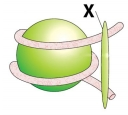
1. Glutamine.
2. Lysine.
3. Tryptophan.
4. Tyrosine.
Marsupial mole and kangaroo are examples of
1. Divergent evolution
2. Convergent evolution
3. Adaptive Radiation
4. Both 1 and 3
Study the given table regarding vertebrates and identified A, B, C and D
| Taxon A |
Character Fish with circular mouth |
Example Hagfish |
| Osteichthyes | Gill is covered by operculum | B |
| Chondrichthyes | C | Scoliodon |
| D | 3 chambered heart | Lepidosiren |
| A | B | C | D |
| 1. Placodermi | Betta | Placoid Scales | Dipnoi |
| 2. Cyclostomata | Clarias | Placoid Scales | Dipnoi |
| 3. Cyclostomata | Pristis | Jawless | Bony Fish |
| 4. Osteichthyes | Pristis | Jawless | Bony Fish |
Bryophytes are:-
| 1. | Always homosporic and exhibit exospheric development of spores |
| 2. | Mostly sporophytic plants |
| 3. | Most successful terrestrial plants |
| 4. | Gametophytic with branched multicellular roots |
How many of the following statements are not true for kingdom Monera ?
(i) Most of the members are prokaryotic
(ii) Some of the monerans can perform photosynthesis
(iii) All the members have cell wall of peptidoglycan
(iv) All the members of monera are devoid of true nucleus
(v) All the members are pathogenic
1. One
2. Two
3. Three
4. Four
Concentration of DDT for first trophic level and fourth trophic level is respectively in aquatic food chains
1. 0.04 ppb, 25 ppm
2. 0.003 ppb, 2 ppm
3. 0.5 ppb, 2 ppm
4. 0.04 ppm, 25 ppm
Cleaning of wastewater in Arcata Marsh involves
1. Only conventional method of sewage treatment
2. Removal of dissolved heavy metals through a biological process
3. Filteration, chlorination like chemical processes
4. Utilisation of microorganisms only for pollution control
Eco-san toilets are not associated with which of the following?
1. Are working in Sri Lanka and Kerala
2. Composting method for recycling of human excreta
3. Recycled material forms natural fertilizer
4. Enhance the need for chemical fertilizers
Choose the correct sequence of greenhouse gases with respect to their relative contribution to global warming in increasing order
1.
2.
3.
4.
The Lassaigne's extract is boiled with a concentration HNO3 while testing for halogens. By doing so it:
1. Helps in the precipitation of AgCl.
2. Increases the solubility product of AgCl.
3. Increases the concentration of NO3- ions.
4. Decomposes Na2S and NaCN, if formed.
A compound forms hcp structure. The total number of voids in 0.5 mol will be-
1. 9.0331023
2. 6.0111023
3. 5.0231023
4. 7.0331023
At room temperature, the average speed of Helium is higher than that of Oxygen by a factor of -
1.
2.
3. 8
4. 6
What volume of ammonia gas at NTP will be required to be passed into 30 mL of 1 to bring down the acid normality to 0.2 N?
1. 480.5 mL
2. 537.6 mL
3. 438.4 mL
4. 556.5 mL
In animals, the stored carbohydrate is:
1. Starch
2. Glycogen
3. Sucrose
4. Fructose
A 500 g toothpaste sample has 0.4 g fluoride concentration. The fluoride concentration in terms of ppm will be -
| 1. | 200 ppm | 2. | 400 ppm |
| 3. | 500 ppm | 4. | 800 ppm |
The number of d-electrons in is not equal to
that of the
1. p-electrons in Ne
2. s-electrons in Mg
3. d-electrons in Co+3
4. p-electrons in
The hybridizations of [Ni(CO)4] and [Cr(H2O)6]3+, respectively, are :
1. sp3 and d3sp2
2. dsp2 and d2sp3
3. sp3 and d2sp3
4. dsp2 and sp3d2
Metallic copper dissolves in
1. Dilute HCl
2. Concentrated HCl+conc. HNO3
3. Aqueous KCN
4. Pure ammonia
(B) and (A) are respectively
1.
2.
3.
4.

The major product (X) in the above reaction is:
| 1. | 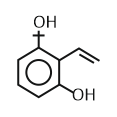 |
2. |  |
| 3. | 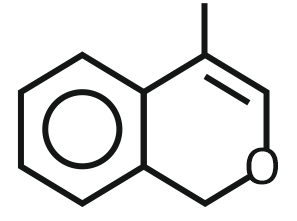 |
4. | 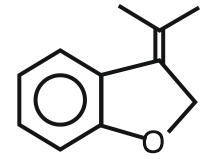 |
Which one of the following has maximum nucleophilicity?
1.
2.
3.
4.
The total number of 3rd period elements with more than one electron in a 3d orbital is:
| 1. | 9 | 2. | 11 |
| 3. | 0 | 4. | 8 |
Percentage ionic character, if electronegativity value of X=2.1 & Y=3.0, is :-
| 1. | 20 | 2. | 30 |
| 3. | 17 | 4. | 23 |
lf kinetic energy of an electron in second shell of H-atom is 40 eV then what will be the total energy of electron in its third shell ?
1. 4.44 eV
2. 1.11 eV
3. 8.88 eV
4. 17.78 eV
lf 0.50 L of a 0.60 M SnS solution is electrolyzed for a period of 30 min using a current of 4.60 A. lf inert electrodes are used then what is the final concentration of S remaining in the solution ?[atomic wt. of Sn =119]
1. 0.342 M
2. 0.6 M
3. 0.389 M
4. 0.514 M
17.4 % (w/v) solution at 27 C is isotonic to 5.85 % (w/V) NaCl solution at 27 C. lf NaCl is 100 % ionised, the % ionisation of in aqueous solution is-
[At wt. of K = 39, Na = 23] :-
1. 25 %
2. 75 %
3. 50 %
4. None of the above
The electrode potential of Cu electrode dipped in 0.025 M CuSO4 solution at 298 K is:
(standard reduction potential of Cu = 0.34 V)
1. 0.047 V
2. 0.293 V
3. 0.35 V
4. 0.387 V
Which of the following pair of species don't give on hydrolysis :
1. H
2.
3.
4.
In the process of extraction of silver,
silver ore +
[X] + Zn [Y] + Ag
[X], and [Y] in the above mentioned reaction are:
1. X= [Ag(CN)]; Y = [Zn(CN)]-2
2. X= [Ag(CN)]-3; Y=[Zn(CN)]-2
3. X= [Ag(CN)]; Y=[Zn(CN)]
4. X=[Ag(CN)] ; Y= [Zn(CN)]2
For a reaction:-
lf rate of consumption of BrO is x mol . Then calculate the rate of formation of Br:-
1.
2.
3.
4. 3x
ln a closed vessel, 50 ml of completely reacts with 200 ml of C2 according to the following equation:
What will be the composition of the gaseous mixture in the system?
1. 100 ml
2. 25 ml
3. 75 ml
4. 10 ml
AB3 (g) dissociates as AB3(g) ⇌ AB2(g) + \(\frac{1}{2}\) B2(g) .When the initial pressure of AB3 is 800 torr and the total pressure developed at equilibrium is 900 torr. What fraction of AB3(g) gets dissociated?
1. 10%
2. 12.5%
3. 25%
4. 30%
The concentration of ion in a solution containing 0.1 M HCN and 0.2 M NaCN will be:
( for HCN = )
1. 3.1
2.
3.
4.
The difference in for combustion of benzoic acid at 300 K is equal to-
1. -1.247 kJ
2. +1.247 kJ
3. -1.247 J
4. +1.247 J
Which of the following compounds will exhibit the lowest heat of hydrogenation/mole?
| 1. |  |
2. |  |
| 3. |  |
4. |  |
Match the polymers given in Column-I with their repeating units given in Column-II. Choose the correct option from the codes given below :
| Column-I | Column-II |
| (a) Polystyrene | (p)  |
| (b) Novolac | (q)  |
| (c) Buna-N | (r)  |
| (d) Acrilan | (s)  |
| (a) | (b) | (c) | (d) | |
| 1. | (s) | (r) | (q) | (p) |
| 2. | (r) | (p) | (s) | (q) |
| 3. | (p) | (q) | (r) | (s) |
| 4. | (q) | (s) | (p) | (r) |
Select the structure of chromium complex formed. When the toluene reacts with chromyl chloride to give benzaldehyde on hydrolysis :
1. 
2. 
3. 
4. 
The compound 'A' having molecular formula undergoes following reaction
The compound 'A' will be :-
1. CH3-CH2-CH2-NH2
2. CH3-CH2-NH-CH3
3.
4.
Among the following the aromatic compound is :-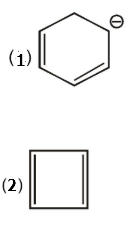

The incorrect statement among the following is :
1. The atomic radius of Na is greater than that of Mg.
2. Density of K is more than Na.
3. Melting point & boiling point of Ca are greater than those of Mg.
4. Mg does not react with cold water.
The reaction, among the following, that cannot produce ethane is:
1.
2.
3.
4.
When 4 g of iron is burnt to ferric oxide at a constant pressure, 29.28 kJ of heat is evolved.
The enthalpy of formation of ferric oxide will be-
(At. mass of Fe = 56) ?
1. 81.98 kJ
2. 819.8 kJ
3. 40.99 kJ
4. +819.8 kJ
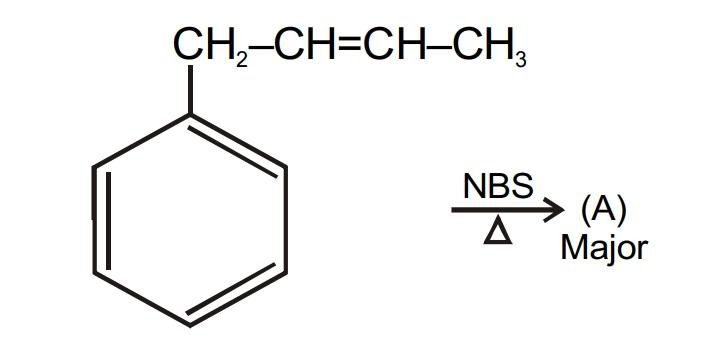
Compound (A) is :
1.
2.
3.
4.
Complex ![]() : Charge of Co is-
: Charge of Co is-
1. +2
2. +3
3. +1
4. +4
Brownian motion of colloidal particles is caused by:
| 1. | Temperature fluctuations within the liquid phase. |
| 2. | Attraction and repulsion between charges on the colloidal particles. |
| 3. | Impact of the molecules of the dispersion medium on the colloidal particles. |
| 4. | None of the above. |
A Brine solution on electrolysis will not give :
1. NaOH
2.
3.
4.
The configuration that shows the outer transition element among the following is:
1. [Rn]7s2
2. [Xe]4f75d16s2
3. [Xe]5d16s2
4. [Rn]5f76d17s2
Given the reaction between 3 gases represented X, Y, Z to give the compound XYZ(g) . At equilibrium concentration of X = 3M, Y = 6M, Z= 9M XYZ = 6M
If the reaction takes place in a sealed vessel at 527°C, then the value of KC
will be :
For HCl solution at , equivalent conductance at infinite dilution, is . The specific conductance of a solution of HCl is . If the apparent degree of dissociation is 90% the normality of the solution is:-
1. 0.90 N
2. 1.0 N
3. 10 N
4. 1.2 N
Which of the following species can act as an oxidising agent?
1.
2.
3.
4.
Which types of isomerism can be exhibited by compounds with the molecular formula C4H11N?
1. Position isomerism
2. Metamerism
3. Functional isomerism
4. All of the above
Which of the following is most basic?
1. Lu
2. Yb
3. Ce
4. Tb
can't be prepared by -
1.
2.
3.
4.
A charge \(q_1=5 \times 10^{-8} ~\text{C}\) is kept at \(3\) cm from a charge \(q_2=-2 \times 10^{-8} ~\text{C}\). The potential energy of the system relative to the potential energy at infinite separation is:
| 1. | \(3\times 10^{-4}~\text{J}\) | 2. | \(-3\times 10^{-4}~\text{J}\) |
| 3. | \(9\times 10^{-6}~\text{J}\) | 4. | \(-9\times 10^{-6}~\text{J}\) |
In a region an electric field making an angle 30 with the horizontal plane is present. A ball having charge 2 C and mass 3 kg is projected with speed 20 m/s at an angle 30 with the horizontal, the horizontal range of the projectile in metre is:-
1. 40
2.
3.
4.
A conducting sphere with a charge Q is surrounded by an uncharged concentric conducting spherical shell. The potential difference between the sphere and the shell is V. If the shell is now given a charge of –3Q, the new potential difference between them is:-
1. V
2. 2V
3. 4V
4. –2V
Suppose you are riding a bike with a speed of \(20~\text{m/s}\) due east relative to a person \(A\) who is walking on the ground towards the east. If your friend \(B\) walking on the ground due west measures your speed as \(30~\text{m/s}\) due east, then the relative velocity between two reference frames \(A\) and \(B\) is:
| 1. | the velocity of \(A\) with respect to \(B\) is \(5~\text{m/s}\) towards the east. |
| 2. | the velocity of \(A\) with respect to \(B\) is \(5~\text{m/s}\) towards the west. |
| 3. | the velocity of \(A\) with respect to \(B\) is \(10~\text{m/s}\) towards the east. |
| 4. | the velocity of \(A\) with respect to \(B\) is \(10~\text{m/s}\) towards the west. |
The position vector of a moving particle at time t is . Its displacement during the time interval, t = 1 s to t = 3 s is :
1.
2.
3.
4.
A \(100\) kg gun fires a ball of \(1\) kg horizontally from a cliff at a height of \(500\) m. It falls on the ground at a distance of \(400\) m from the bottom of the cliff. The recoil velocity of the gun is: (Take \(g=10\) m/s2)
1. \(0.2\) m/s
2. \(0.4\) m/s
3. \(0.6\) m/s
4. \(0.8\) m/s

| 1. |
\(\overrightarrow N+\overrightarrow T+\overrightarrow W=0\) |
2. | \(T^2=N^2+W^2\) |
| 3. | \(T = N + W\) | 4. | \(N = W \tan \theta\) |
The resistances of three parts of a circular loop are as shown in the figure. What will be the magnetic field at the centre of \(O\)
(current enters at \(A\) and leaves at \(B\) and \(C\) as shown)?

| 1. | \(\dfrac{\mu_{0} I}{6 a}\) | 2. | \(\dfrac{\mu_{0} I}{3 a}\) |
| 3. | \(\dfrac{2\mu_{0} I}{3 a}\) | 4. | \(0\) |
At any place on earth, the horizontal component of the earth's magnetic field is times the vertical component. The angle of dip at that place will be
1. 60°
2. 45°
3. 90°
4. 30°
A uniform disc of mass m and radius R is rolling down a rough inclined plane which makes an angle 30° with the horizontal. If the coefficients of static and kinetic friction are each equal to µ and the only forces acting are gravitational and frictional, then the magnitude of the frictional force acting on the disc is:-
1. (mg/3) upwards
2. (mg/3) downwards
3. (mg/6) upwards
4. (mg/6) downwards
A uniform tube is shown in the figure which is open at one end and closed at the other. To enclose a column of air inside the tube, a pellet of mercury is introduced. If the length of air column at 27°C is 18 cm, at what temperature its length will be 21.6 cm?
1. 87°C
2. 91°C
3. 85°C
4. 97°C
Carnot cycle (reversible) of a gas, represented by a pressure-volume curve is shown in the diagram.
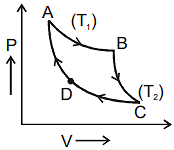
Consider the following statements:-
I. Area ABCD = Work done on the gas
II. Area ABCD = Net heat absorbed
III. Change in the internal energy in cycle = 0
Which of these is correct?
1. I only
2. II only
3. II and III
4. I, II and III
The figure shows a polytropic process for an ideal gas. The work done by the gas will be in process AB is
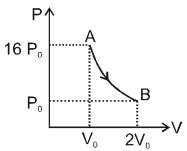
1.
2.
3.
4. Insufficient information
If the same amount of heat is supplied to two spheres of the same material having the same radius (one is hollow and the other is solid), then:
| 1. | the expansion in hollow is greater than the expansion in solid |
| 2. | the expansion in hollow is the same as that in solid |
| 3. | the expansion in hollow is lesser than in solid |
| 4. | the temperature of both must be the same |
The angular resolution of a 10 cm diameter telescope for the wavelength of 5000 Å is of the order:-
1.
2.
3.
4.
A light ray from the air is incident (as shown in the figure) at one end of glass fibre (refractive index \(\mu= 1.5\)) making an incidence angle of \(60^{\circ}\) on the lateral surface so that it undergoes a total internal reflection. How much time would it take to traverse the straight fibre of a length of \(1\) km?
1. \(3.33~\mu\text{s}\)
2. \(6.67~\mu\text{s}\)
3. \(5.77~\mu\text{s}\)
4. \(3.85~\mu\text{s}\)
The radius of a soap bubble is increased from 1/ cm to 2/ cm. If the surface tension of the soap solution is 30 dynes per cm, then the work done will be:
1. 180 ergs
2. 360 ergs
3. 720 ergs
4. 960 ergs
The breaking stress of a wire going over a smooth pulley in the following question is \(2\times 10^{9}~\text{N/m}^2.\) What would be the minimum radius of the wire used if it is not to break?

| 1. | \(0.46\times10^{-6}~\text{m}\) | 2. | \(0.46\times10^{-4}~\text{m}\) |
| 3. | \(0.46\times10^{8}~\text{m}\) | 4. | \(0.46\times10^{-11}~\text{m}\) |
| 1. | \(mgR_e\) | 2. | \(2mgR_e\) |
| 3. | \(\frac{mgR_e}{5}\) | 4. | \(\frac{mgR_e}{16}\) |
The displacement-time graph of a particle executing SHM is shown in the figure. Its displacement equation is: (Time period = \(2~\text{s}\))

1. \(x=10\sin \left(\pi t +\frac{\pi}{6}\right)\)
2. \(x=10\sin (\pi t )\)
3. \(x=10\cos (\pi t )\)
4. \(x=5\sin \left(\pi t +\frac{\pi}{6}\right)\)
Given the value of Rydberg constant is , the wavenumber of the last line of the Balmer series in hydrogen spectrum will be:-
1.
2.
3.
4.

| 1. | \(A\) | 2. | \(B\) |
| 3. | \(C\) | 4. | None of these |
| 1. | the drift of holes. |
| 2. | diffusion of charge carriers. |
| 3. | migration of impurity ions. |
| 4. | drift of electrons. |
| 1. | (i) < (ii) < (iii) | 2. | (iii) < (ii) < (i) |
| 3. | (ii) = (iii) < (i) | 4. | (i) = (iii) < (ii) |
If , then the value of is:-
1.
2. A + B
3.
4.
In an experiment, the height of an object measured by a vernier callipers having least count of \(0.01~\text{cm}\) is found to be \(5.72~\text{cm}\). When no object is there between jaws of this vernier callipers, the reading of the main scale is \(0.1\) cm and the reading of the vernier scale is \(0.3~\text{mm}\). The correct height of the object is:
1. \( 5.72 ~\text{cm} \)
2. \( 5.59~\text{cm} \)
3. \( 5.85~\text{cm} \)
4. \( 5.69~\text{cm} \)
When electric bulbs of the same power, but different marked voltage, are connected in series across the power source, their brightness will be:
| 1. | Proportional to their marked voltage |
| 2. | Inversely proportional to their marked voltage |
| 3. | Proportional to the square of their marked voltage |
| 4. | Inversely proportional to the square of their marked voltage |
Given, \(F=2x^{2}-3x-2.\) Choose correct option:
| 1. | \(x = -1/2\) is position of stable equilibrium |
| 2. | \(x = 2\) is position of stable equilibrium |
| 3. | \(x = -1/2\) is position of unstable equilibrium |
| 4. | \(x =2\) is position of neutral equilibrium |
Two identical charged particles enter a uniform magnetic field with the same speed but at angles 30° and 60° with the field. Let a, b and c be the ratio of their time periods, radii and pitches of the helical paths then
1. abc = 1/
2. abc > 1
3. abc < 1
4. a = bc
Some magnetic flux is changed from a coil of resistance \(10~\Omega\). As a result, an induced current is developed in it, which varies with time as shown in the figure. The magnitude of change in flux through the coil in Wb is:

| 1. | \(2\) | 2. | \(4\) |
| 3. | \(6\) | 4. | None of these |
Four particles of mass \(m_1 =2m,~m_2 = 4m,\) \(m_3= m,\) and \(m_4\) are placed at four corners of a square. What should be the value of \(m_4\) so that the centre of mass of all four particles is exactly at the centre of the square?

1. \(2m\)
2. \(8m\)
3. \(6m\)
4. none of these
A \(10\) H inductor carries a current of \(20\) A. How much ice at \(0^{\circ}\text{C}\) could be melted by the energy stored in the magnetic field of the inductor?
Latent heat of ice is \(2.26\times 10^{3}\) J/kg .
| 1. | \(0.08\) kg | 2. | \(8.8\) kg |
| 3. | \(0.88\) kg | 4. | \(0.44\) kg |

A rod is falling down with constant velocity \(V_0\) as shown. It makes contact with hinge A and rotates around it. The angular velocity of the rod just after the moment when it comes in contact with hinge A is:
| 1. | \(2 \mathrm{V}_0 / 3 \mathrm{L} \) | 2. | \(3 \mathrm{V}_0 / 2 \mathrm{L} \) |
| 3. | \(\mathrm{V}_0 / \mathrm{L} \) | 4. | \(2 \mathrm{V}_0 / 5 \mathrm{L}\) |
The correct mirror image of the figure is:

| 1. |  |
2. |  |
| 3. |  |
4. |  |
The count rate from 100 of a radioactive liquid is C. Some of this liquid is now discarded. The count rate of the remaining liquid is found to be C/10 after three half-lives. The volume of the remaining liquid in is:
1. 20
2. 40
3. 60
4. 80
The coefficient of friction between the block of masses \(m\) and \(2m\) is \(\mu = 2\tan\theta\). There is no friction between the block of mass \(2m\) and inclined plane. The maximum amplitude of the two-block system for which there is no relative motion between both blocks is:

1. \(g\sin\theta \sqrt{\frac{K}{m}}\)
2. \(\dfrac{mg\sin\theta}{K}\)
3. \(\dfrac{3mg\sin\theta}{K}\)
4. \(\dfrac{\mu mg}{K}\)
A vibrating tuning fork of frequency \(1000~\text{Hz}\) is placed near the open end of a long cylindrical tube. The tube has a side opening and is also fitted with a movable reflecting piston. As the piston is moved through \(x\) distance, the intensity of sound changes from a maximum to a minimum for an observer at the side opening. If the speed of sound is \(350\) meters per second, then \(x\) is:

1. \(35~\text{cm}\)
2. \(17.5~\text{cm}\)
3. \(8.75~\text{cm}\)
4. \(10~\text{cm}\)
The combination of gates shown below is equivalent to:
1. AND gate
2. XOR gate
3. NOR gate
4. NAND gate

| 1. | \({V_1}\) increases. |
| 2. | \({V_2}\) increases. |
| 3. | \({V_2}\) & \({V_3}\) both increases. |
| 4. | one of \(V_2\) & \({V_3}\) increases and \({V_1}\) decreases. |
With an increase in temperature, the viscosity of:
1. gases decreases and liquids increases.
2. gases increases and liquids decreases.
3. both gases and liquids increases.
4. both gases and liquids decrease.
If alpha, beta and gamma rays carry the same momentum, which has the longest wavelength?
| 1. | Alpha rays | 2. | Beta rays |
| 3. | Gamma rays | 4. | None, all have same wavelength |
A bus is moving with a velocity of 5 m/s towards a huge wall. The driver sounds a horn at a frequency of 165 Hz. If the speed of sound in air is equal to 335 m/s, the number of beats heard per second by a passenger on the bus will be:
| 1. | 3 | 2. | 4 |
| 3. | 5 | 4. | 6 |